Planning worship?
Check out our sister site, ZeteoSearch.org,
for 20+ additional resources related to your search.
- |
User Links
Person Results
Charles C. Converse
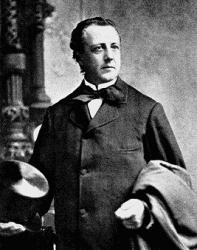
1832 - 1918 Person Name: C. C. Converse Composer of "[Pilgrim! burdened with thy sin]" in Songs of the Covenant Pseudonyms: Clare, Lester Vesé, Nevers, Karl Reden, Revons
=================================
Charles Crozat Converse LLD USA 1832-1918. Born in Warren, MA, he went to Leipzig, Germany to study law and philosophy, as well as music theory and composition under Moritz Hauptmann, Friedrich Richter, and Louis Plaidy at the Leipzig Conservatory. He also met Franz Liszt and Louis Spohr. He became an author, composer, arranger and editor. He returned to the states in 1859 and graduated from the Albany, NY, Law School two years later. He married Lida Lewis. From 1875 he practiced law in Erie, PA, and also was put in charge of the Burdetta Organ Company. He composed hymn tunes and other works. He was offered a DM degree for his Psalm 126 cantata, but he declined the offer. In 1895 Rutherford College honored him with a LLD degree. He spent his last years in Highwood, NJ, where he died. He published “New method for the guitar”, “Musical bouquet”, “The 126th Psalm”, “Sweet singer”, “Church singer”, “Sayings of Sages” between 1855 and 1863. he also wrote the “Turkish battle polka” and “Rock beside the sea” ballad, and “The anthem book of the Episcopal Methodist Church”.
John Perry
Charles C. Converse
Ray Palmer

1808 - 1887 Translator of "O Bread to Pilgrims Given" in Gloria Deo Ray Palmer (b. Little Compton, RI, 1808; d. Newark, NJ, 1887) is often considered to be one of America's best nineteenth-century hymn writers. After completing grammar school he worked in a Boston dry goods store, but a religious awakening prodded him to study for the ministry. He attended Yale College (supporting himself by teaching) and was ordained in 1835. A pastor in Congregational churches in Bath, Maine (1835-1850), and Albany, New York (1850-1865), he also served as secretary of the American Congregational Union (1865-1878). Palmer was a popular preacher and author, writing original poetry as well as translating hymns. He published several volumes of poetry and hymns, including Sabbath Hymn Book (1858), Hymns and Sacred Pieces (1865), and Hymns of My Holy Hours (1868). His complete poetical works were published in 1876.
Bert Polman
===================
Palmer, Ray, D.D., son of the Hon. Thomas Palmer, a Judge in Rhode Island, was born at Little Compton, Rhode Island, Nov. 12, 1808. His early life was spent at Boston, where he was for some time clerk in a dry-goods store. At Boston he joined the Park Street Congregational Church, then under the pastoral care of Dr. S. E. Dwight. After spending three years at Phillips Academy, Andover, he entered Yale College, New Haven, where he graduated in 1830. In 1835 he became pastor of the Central Congregational Church, Bath, Maine. During his pastorate there he visited Europe in 1847. In 1850 he was appointed to the First Congregational Church, at Albany, New York, and in 1865 Corresponding Secretary to the American Congregational Union, New York. He resigned in 1878, and retired to Newark, New Jersey. He died at Newark, Mar. 29, 1887. Dr. Palmer's published works in prose and verse include:--
(1) Memoirs and Select Remains of Charles Pond, 1829; (2) The Spirit's Life, a Poem, 1837; (3) How to Live, or Memoirs of Mrs. C. L. Watson, 1839; (4) Doctrinal Text Book, 1839; (5) Spiritual Improvement, 1839, republished as Closet Hours in 185; (6) What is Truth? or Hints on the Formation of Religious Opinions, 1860; (7) Remember Me, or The Holy Communion, 1865; (8) Hymns and Sacred Pieces, with Miscellaneous Poems, 1865; (9) Hymns of my Holy Hours, and Other Pieces, 1868; (10) Home, or the Unlost Paradise, 1873; and (11) Voices of Hope and Gladness, 1881.
Most of Dr. Palmer's hymns have passed into congregational use, and have won great acceptance. The best of them by their combination of thought, poetry, and devotion, are superior to almost all others of American origin. The first which he wrote has become the most widely known of all. It is:—
1. My faith looks up to Thee. Faith in Christ. This hymn was written by the author when fresh from College, and during an engagement in teaching in New York. This was in 1830. The author says concerning its composition, "I gave form to what I felt, by writing, with little effort, the stanzas. I recollect I wrote them with very tender emotion, and ended the last line with tears." A short time afterwards the hymn was given to Dr. Lowell Mason for use, if thought good, in a work then being compiled by him and Dr. T. Hastings. In 1831 that work was published as Spiritual Songs for Social Worship: adapted to the use of Families, &c. Words and Music arranged by Thomas Hastings, of New York, and Lowell Mason of Boston. It is No. 141 in 4 stanzas of 8 lines, entitled "Self Consecration," and accompanied with the tune by Dr. L. Mason, there given as "My faith looks up to Thee, "but subsequently known as Olivet. (Orig. text of hymn in Thring's Collection, 1882.) It has passed into most modern collections in all English-speaking countries, and has been rendered into numerous languages. That in Latin, by H. M. Macgill (p. 708, ii.), begins "Fides Te mea spectat."
2. Fount of everlasting love. Praise for renewed Spiritual Life. This also appeared in the Spiritual Songs, &c, 1831, No. 191, in 4 stanzas of 4 lines, and headed "Praise for a Revival."
The hymns which are given below are all in Dr. Palmer's Poetical Works, N. Y., 1876, and the dates appended in brackets are those given by him in that work.
3. Thou who roll'st the year around. (1832.) Close of the Year. In several American collections.
4. Away from earth my spirit turns. (1833.) Holy Communion. Appeared in Lowell Mason's Union Hymns, in 4 stanzas of 4 lines. In the Church Praise Book, N. Y.. 1882, it begins with st. ii., "Thou, Saviour, art the Living Bread."
5. Before Thy throne with tearful eyes. (1834.) Liberty of Faith.
6. Stealing from the world away. (1834.) Evening. Written at New Haven in 1834, and is very popular in America.
7. Thine [Thy] holy day's returning. (1834.) Sunday Morning.
8. Wake thee, 0 Zion. (1862.) Zion Exultant.
9. We stand in deep repentance. (1834.) Lent.
This last, No. 9, in common with Nos. 10, 11, 12, is marked "original," in the Presbyterian Parish Hymns, 1843. Probably they were given to the editors of that book in manuscript, and had not previously appeared.
10. And is there, Lord, a rest? (1843.) Rest in Heaven. Written at Bath, Maine, in 1843.
11. 0 sweetly breathe the lyres above. Consecration to Christ. This was accidentally omitted from Dr. Palmer's Poetical Works, 18?6. S. W. Duffield says:—
"It was written in the winter of 1842-43, at a time of revival. At the previous Communion several had been received under circumstances that made Doddridge's hymn, ‘0 happy day that fixed my choice 'a most appropriate selection. Not caring to repeat it, and needing something similar, Dr. Palmer composed the present hymn." English Hymns, N. Y., 1886, p. 432.
12. When downward to the darksome tomb. (1842.) Death Contemplated. Written at Bath, Maine, 1842.
From 1843 there comes a long break, and Dr. Palmer seems to have done no more hymn-writing until called upon by Professors Park and Phelps, of Andover, for contributions to their Sabbath Hymn-Book, 1858. His hymns written for that important collection rank amongst the best that America has produced. This is specially true of the first four (Nos. 13-16) from the Latin.
13. Jesus, Thou joy of loving hearts. (l858.) Translation of a cento from "Jesu dulcis memoria" (p. 588, ii.).
14. 0 Bread to Pilgrims given. (1858.) Translation of “O esca viatorum" (q.v.).
15. 0 Christ our King, Creator Lord. (1858.) Translation of “Rex Christe, factor omnium "
16. Come Holy Ghost, in love. (1858.) Translation of “Veni Sancte Spiritus" (q.v.)
17. Jesus, these eyes have never seen. (1858.) Christ loved, though unseen. This hymn is accounted by many as next in merit and beauty to "My faith looks up to Thee."
18. Lord, my weak thought in vain would climb. (1858.) God Unsearchable. This hymn deals with the mysteries of Predestination in a reverent and devout manner.
19. Thy Father's house! thine own bright home. (1858.) Heaven.
The next group, Nos. 20-27, appeared in Dr. Robinson's Songs for the Sanctuary, 1865.
20. Lord, Thou wilt bring the joyful day. (1864.) Contemplation of Heaven. Written in New York City.
21. Eternal Father, Thou hast said. (i860.) Missions.
22. Jesus, Lamb of God, for me. (1863.) Jesus, the Way of Salvation. Written in Albany, New York.
23. Take me, 0 my Father, take me. (1864.) Lent.
24. Wouldst thou eternal life obtain. (1864.) Good Friday.
25. Come Jesus, Redeemer, abide Thou with me. (1864.) Holy Communion.
26. Lord, Thou on earth didst love Thine own. (1864.) Fellowship with Christ.
27. Thou, Saviour, from Thy throne on high. (1864.) Prayer.
The next four (Nos. 28-31) present another group. They appeared in D. E. Jones's Songs for the New Life, 1869, and the Reformed Dutch Hymns of the Church, N. Y., 1869. The dates of composition are from Dr. Palmer's Poems, 1876.
28. Lord, Thou hast taught our hearts to glow. (1865.) Ordination, or Meeting of Ministers.
29. When inward turns my searching gaze. (1868.) Evening.
30. 0 Jesus, sweet the tears I shed. (1867.) Good Friday.
31. Jesus, this [my] heart within me burns. (1868.) Love.
The hymns which follow are from various sources.
32. 0 Christ, the Lord of heaven, to Thee. (1867.) Universal Praise to Christ. Appeared in the author's Hymns of my Holy Hours, 1867. It is a hymn of great merit, and is widely used.
33. Behold the shade of night is now receding. (1869.) A translation of "Ecce jam noctis." (p. 320, i., and Various).
34. Hid evening shadows let us all be waking. (1869.) A translation of "Nocte surgentes" (p. 809, i.).
35. I give my heart to Thee. (Aug. 20, 1868.) A translation of "Cor meum Tibi dedo," p. 262, ii.
36. Holy Ghost, that promised came. (1873.) Whitsuntide. From the author's Poems, 1876.
37. 0 Holy Comforter, I hear. The Comforter. Appeared in the Boston Congregationalist, September 7th, 1867.
38. Lord, when my soul her secrets doth reveal. (1865.) Holy Communion.
Most of the foregoing hymns are in common in Great Britain, and all are found in one or more American hymnbooks of importance. [Rev. F. M. Bird, M.A.]
-- John Julian, Dictionary of Hymnology (1907)
===================
Palmer, Ray, D.D., p. 877, i. The following original hymns by Dr. Palmer are also in common use:—
1. O Rock of Ages, since on Thee. Faith. From his Poetical Works, 1876, p. 27, where it is dated 1869. Bp. Bickersteth says "This hymn"... is "worthy of Luther." (Note Hymnal Companion, ed. 1876.)
2. Thy holy will, my God, be mine. Resignation. From his Hymns of my Holy Hours, &c, 1868, p. 47. Also in his P. Works, 1876, dated 1867.
3. We praise Thee, Saviour, for Thy grace. Holy Communion. From his Hymns and Sacred Pieces, &c, 1865. Also in P. Works, 1876, dated 1864.
--John Julian, Dictionary of Hymnology, Appendix, Part II (1907)
==========
Ray Palmer was born at Little Compton, Rhode Island, in 1808. He studied at Phillip's Academy, Andover, Mass., and graduated at Yale College in 1830. In 1835, he was ordained pastor of a Congregational Society in Bath, Maine, from which he removed, in 1850, to the pastorate of a Congregational Society in Albany, N.Y. He has published many hymns, some of his own authorship, and some translations. He has published some sermons and reviews.
--Annotations of the Hymnal, Charles Hutchins, M.A. 1872.
Ray Palmer
William B. Bradbury

1816 - 1868 Person Name: William Batchelder Bradbury, 1816-1868 Composer of "WHITHER, PILGRIMS" in The Book of Praise William Batchelder Bradbury USA 1816-1868. Born at York, ME, he was raised on his father's farm, with rainy days spent in a shoe-shop, the custom in those days. He loved music and spent spare hours practicing any music he could find. In 1830 the family moved to Boston, where he first saw and heard an organ and piano, and other instruments. He became an organist at 15. He attended Dr. Lowell Mason's singing classes, and later sang in the Bowdoin Street church choir. Dr. Mason became a good friend. He made $100/yr playing the organ, and was still in Dr. Mason's choir. Dr. Mason gave him a chance to teach singing in Machias, ME, which he accepted. He returned to Boston the following year to marry Adra Esther Fessenden in 1838, then relocated to Saint John, New Brunswick. Where his efforts were not much appreciated, so he returned to Boston. He was offered charge of music and organ at the First Baptist Church of Brooklyn. That led to similar work at the Baptist Tabernacle, New York City, where he also started a singing class. That started singing schools in various parts of the city, and eventually resulted in music festivals, held at the Broadway Tabernacle, a prominent city event. He conducted a 1000 children choir there, which resulted in music being taught as regular study in public schools of the city. He began writing music and publishing it. In 1847 he went with his wife to Europe to study with some of the music masters in London and also Germany. He attended Mendelssohn funeral while there. He went to Switzerland before returning to the states, and upon returning, commenced teaching, conducting conventions, composing, and editing music books. In 1851, with his brother, Edward, he began manufacturring Bradbury pianos, which became popular. Also, he had a small office in one of his warehouses in New York and often went there to spend time in private devotions. As a professor, he edited 59 books of sacred and secular music, much of which he wrote. He attended the Presbyterian church in Bloomfield, NJ, for many years later in life. He contracted tuberculosis the last two years of his life.
John Perry
William B. Bradbury
Chas. H. Gabriel
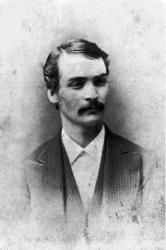
1856 - 1932 Composer of "[I'm a pilgrim and I'm a stranger] (Gabriel)" in Assembly Songs Pseudonyms: C. D. Emerson, Charlotte G. Homer, S. B. Jackson, A. W. Lawrence, Jennie Ree
=============
For the first seventeen years of his life Charles Hutchinson Gabriel (b. Wilton, IA, 1856; d. Los Angeles, CA, 1932) lived on an Iowa farm, where friends and neighbors often gathered to sing. Gabriel accompanied them on the family reed organ he had taught himself to play. At the age of sixteen he began teaching singing in schools (following in his father's footsteps) and soon was acclaimed as a fine teacher and composer. He moved to California in 1887 and served as Sunday school music director at the Grace Methodist Church in San Francisco. After moving to Chicago in 1892, Gabriel edited numerous collections of anthems, cantatas, and a large number of songbooks for the Homer Rodeheaver, Hope, and E. O. Excell publishing companies. He composed hundreds of tunes and texts, at times using pseudonyms such as Charlotte G. Homer. The total number of his compositions is estimated at about seven thousand. Gabriel's gospel songs became widely circulated through the Billy Sunday-Homer Rodeheaver urban crusades.
Bert Polman
Chas. H. Gabriel
A. H. Ackley
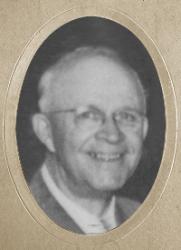
1887 - 1960 Person Name: Alfred Henry Ackley Author of "All the Way with Jesus" in The Cyber Hymnal Alfred Henry Ackley was born 21 January 1887 in Spring Hill, Pennsylvania. He was the youngest son of Stanley Frank Ackley and the younger brother of B. D. Ackley. His father taught him music and he also studied at the Royal Academy of Music in London. He graduated from Westminster Theological Seminary in Maryland and was ordained as a Presbyterian minister in 1914. He served churches in Pennsylvania and California. He also worked with the Billy Sunday and Homer Rodeheaver evangelist team and for Homer Rodeheaver's publishing company. He wrote around 1500 hymns. He died 3 July 1960 in Los Angeles.
Dianne Shapiro (from ackleygenealogy.com by Ed Ackley and Allen C. Ackley)
A. H. Ackley
Jennie Wilson
1857 - 1913 Author of "Marching home" in Sifted Wheat Wilson, Jennie Bain. (d. 3 September 1913). Obituaries available in the DNAH Archives.
===============================
Jennie Bain Wilson, 1857-1913
Born: 1857, on a Farm Near South Whitley, Indiana.
Died: Circa 1913.
Afflicted with a spinal condition at age four, Wilson spent her life in a wheel chair. She never attended school, but was educated at home. She is said to have written over 2,200 texts.
© The Cyber Hymnal™ (www.hymntime.com/tch)
Jennie Wilson
I. B. Woodbury
1819 - 1858 Composer of "I'M A PILGRIM" in International Song Service Woodbury, Isaac Baker. (Beverly, Massachusetts, October 23, 1819--October 26, 1858, Columbia, South Carolina). Music editor. As a boy, he studied music in nearby Boston, then spent his nineteenth year in further study in London and Paris.
He taught for six years in Boston, traveling throughout New England with the Bay State Glee Club. He later lived at Bellow Falls, Vermont, where he organized the New Hampshire and Vermont Musical Association. In 1849 he settled in New York City where he directed the music at the Rutgers Street Church until ill-health caused him to resign in 1851. He became editor of the New York Musical Review and made another trip to Europe in 1852 to collect material for the magazine. in the fall of 1858 his health broke down from overwork and he went south hoping to regain his strength, but died three days after reaching Columbia, South Carolina.
He published a number of tune-books, of which the Dulcimer, of New York Collection of Sacred Music, went through a number of editions. His Elements of Musical Composition, 1844, was later issued as the Self-instructor in Musical Composition. He also assisted in the compilation of the Methodist Hymn Book of 1857.
--Leonard Ellinwood, DNAH Archives
I. B. Woodbury
Haldor Lillenas

1885 - 1959 Composer of "[We're a faithful pilgrim band]" in His Worthy Praise Rv Haldor Lillenas DMus Norway/USA 1885-1959. Born at Stord, near Bergen, Norway, his father sold their 15 acre farm in Norway and emigrated to the U.S., buying a farm in Colton, SD. After he built a sod house, the family (wife and three chldren) also came to SD in 1887. They moved to Astoria, Oregon in 1889, where Lillenas learned English and began writing song lyrics at an early age. In 1900 the family moved again to Roseville, MN, where he worked as a farm laborer and began attending a Lutheran high school at Hawick, MN. He sold a few songs at age 19. At age 21 he began writing more songs, encouraged by some earlier ones becoming popular (“He set me free” was one). His mother died in 1906 and his father returned to ND, but Lillenas decided to move back to Astoria, OR, to finish a chemical correspondence course he had been taking. There he found employment in a chemical factory. He started attending a Lutheran church, but one evening he heard the song, “Tell mother I’ll be there”, sung at a mission. It made him decide to commit his life to Christ. An elderly lady who worked there told him about Jesus, and he began attending the Peniel Mission, a holiness rescue mission in Astoria, OR. He started working at the mission himself. In 1907 he moved to Portland, OR, where he worked with the Peniel Mission there, the mission paying most of his expenses. He was appointed leader of the mission. He saw many there come to know Christ and felt called to the Lord’s work. He joined the First Church of the Nazarene in Portland. Soon he enrolled in a ministerial course of study by correspondence. Soon afterward, he joined a vocal group associated with the Salvation Army called the ‘Charioteers Brigade’, which held street meetings and revival services throught much of CA. As a result of generous donations made, and efforts by his pastor, A O Hendricks, he was able to attend Pacific Bible College (later renamed Pasadena College), Los Angeles, CA. He also found part-time work to help support himself. He was soon a music director at a local church, and was preaching and writing songs. He also studied voice at the Lyric School of Music in Los Angeles, CA. While at Deets, he met and married Bertha Mae Wilson, also on an evangelistic team. Both preached. She was a songwriter like he. They practiced music at her father’s house and found that their voices blended well. They had two children: Evangline, and Wendell. They eventually became elders in the Nazarene Church, and she eventually became an ordained minister as well. He also studied music at the Siegel-Myers School of Music Chicago, IL. He composed songs for cantatas, Christmas, Easter, and special day services. He also used several pseudonyms in their composition. He traveled as an evangelist, then he pastored several churches (1910-1924) at Lompoc, CA, then Redlands, CA, and later in Indianapolis, IN. While there, In 1924, he founded the Lillenas Music Company (bought by the Nazarene Publishing Company in 1930). His wife preached at their pastorate until he was able to get the company up and running. While they owned the company, they published more than 700,000 hymnals. He worked as an editor there (after selling his company) until his retirement in 1950, becoming an advisor for them until his death. Also that year Lillenas purchased a 500 acre rural estate in Miller County, MO, where they built an Ozark home called ‘Melody Lane’. Lillenas joined the American Society of Composers, Authors, and Publishers (ASCAP) in 1938. In 1941 he received an honorable doctorate degree from Olivet Nazarene College, Bourbonnais, IL. In 1945 Bertha died of cancer, and later that year Lillenas remarried to a Lola Dell, and they lived in Melody Lane until 1955, when they moved to Pasadena, CA, attending the Nazarene Church there. They also made three trips to Norway after his retirement, and he wrote three books during that time: “Modern gospel song stories (1952), “Down Melody Lane (an autobiography): (1953), “Motoring 11,000 miles through Norway-A guide for tourists” (1955). In 1955 they toured Israel and sponsored a Palestinian Greek Orthodox family he had met as immigrants to the US that included Sirhan Bishara Sirhan (born in 1944). After they arrived in Pasadena, the Sirhan family stayed with Lillenas for several months, after which the Sirhans moved to a home Lillenas rented and furnished to them. When Mary Sirhan’s husband abandoned her and her two sons and returned to Jordan, Lillenas ensured that they were able to remain in the US. S B Sirhan was the convicted killer of Robert Kennedy. Lillenas wrote some 4000 hymn lyrics, supplying some for evangelists. Four of his song books contain his hymns: “Special sacred songs” (1919), “New Sacred Songs”, “Strains of love”, and “Special sacred songs #2”. He died at Aspen, CO. He is buried at Kansas City, MO. He was an author, editor, compiler, composer, and contributor. He edited and compiled over 50 song books.
John Perry
Haldor Lillenas
J. R. Baxter
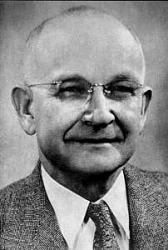
1887 - 1960 Person Name: J. R. Baxter Jr. Author of "Sunset Is Coming, But the Sunrise We’ll See" in Favorites Number 6 Jesse Randall (Pap) Baxter, Jr. (1887-1960)
Born: December 8, 1887, Lebanon, Alabama.
Died: January 21, 1960.
Baxter grew up in DeKalb County, Alabama. In 1926, he bought part of Virgil Stamps’ Gospel music firm, which became the Stamps-Baxter Music and Printing Company, one of the most successful Gospel music publishers of the early 20th Century. Baxter ran the company’s Chattanooga, Tennessee, office until Stamps’ death in 1940, then moved to Dallas, Texas, to run the main office. After Baxter’s death, his wife, Clarice, ran the business until she died; it was then sold to Zondervan. Baxter was inducted into the Southern Gospel Music Association Hall of Fame in 1997.
Lyrics--
After the Sunrise
Farther Along
God Shall Wipe Away All Tears (© 1940)
He Bore It All
I Have Peace in My Soul
I Hold His Hand (© 1929)
I Love My Savior, Too
I Want to Help Some Weary Pilgrim
I’m Living in Canaan Now
Living Grace
Praise the Lamb of God
Something Happens
Travel the Sunlit Way
Try Jesus
When He Blessed My Soul
When We Meet to Part No More
© Cyber Hymnal™ (www.hymntime.com/tch)
J. R. Baxter
Joseph Haydn
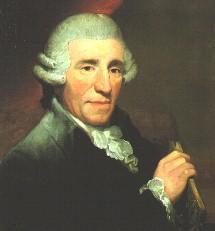
1732 - 1809 Person Name: F. J. Haydn, 1732-1809 Composer of "MANOAH" in Methodist Hymn and Tune Book Franz Joseph Haydn (b. Rohrau, Austria, 1732; d. Vienna, Austria, 1809) Haydn's life was relatively uneventful, but his artistic legacy was truly astounding. He began his musical career as a choirboy in St. Stephen's Cathedral, Vienna, spent some years in that city making a precarious living as a music teacher and composer, and then served as music director for the Esterhazy family from 1761 to 1790. Haydn became a most productive and widely respected composer of symphonies, chamber music, and piano sonatas. In his retirement years he took two extended tours to England, which resulted in his "London" symphonies and (because of G. F. Handel's influence) in oratorios. Haydn's church music includes six great Masses and a few original hymn tunes. Hymnal editors have also arranged hymn tunes from various themes in Haydn's music.
Bert Polman
Joseph Haydn


 My Starred Hymns
My Starred Hymns

